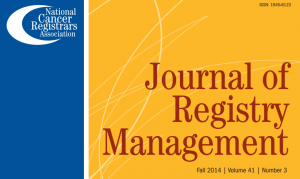
Hannah K. Weir, Ph.D, Senior Epidemiologist, Centers for Disease Control and Prevention (NAACCR Steering Committee Chair)
In the near future, cancer is predicted to become the leading cause of death in the United States. It’s already the leading cause of premature deaths. Every year, we report the rate of cancer deaths is going down while the number of cancer deaths increases. And that is unlikely to change in coming years, as the proportion of older people – those at greatest risk of dying from cancer – increases. Many of these deaths are avoidable, either by preventing the cancer in the first place or by diagnosing it early and providing high-quality cancer treatment.
How can we address this problem and reduce suffering and death from cancer? CDC and its partners developed cancer mortality objectives for Healthy People (HP) 2020, calling for a 10% to 15% reduction in cancer death rates between 2007 and 2020 for selected cancers.
In a new study, just released in Preventing Chronic Disease, we used population projections and trends in cancer death rates to see if we will meet the HP2020 objectives. Additional information can be found here.
Much of the news is encouraging: from 2007 to 2020, death rates are predicted to continue decreasing and to meet HP2020 objectives for cancers of the female breast, lung and bronchus, cervix and uterus, colon and rectum, oral cavity and pharynx, and prostate. We were disappointed to find that this is not true for melanoma.
Our findings point to the need to increase efforts to promote cancer prevention and improve survival to counter the impact of a growing and aging population on the cancer burden and to meet melanoma target death rates. In the coming years, we will continue to monitor and report on trends in cancer incidence and deaths. This monitoring is particularly important where screening can either prevent cancer (cervical and colorectal cancers) or find it early (cervical, colorectal, and female breast cancers), when treatment can be most effective.
Click here to view original article (The abstract below is from the Centers for Disease Control and Prevention article ‘Meeting the Healthy People 2020 Objectives to Reduce Cancer Mortality’)
Abstract
Introduction: Healthy People 2020 (HP2020) calls for a 10% to 15% reduction in death rates from 2007 to 2020 for selected cancers. Trends in death rates can be used to predict progress toward meeting HP2020 targets.
Methods: We used mortality data from 1975 through 2009 and population estimates and projections to predict deaths for all cancers and the top 23 cancers among men and women by race. We apportioned changes in deaths from population risk and population growth and aging.
Results: From 1975 to 2009, the number of cancer deaths increased among white and black Americans primarily because of an aging white population and a growing black population. Overall, age-standardized cancer death rates (risk) declined in all groups. From 2007 to 2020, rates are predicted to continue to decrease while counts of deaths are predicted to increase among men (15%) and stabilize among women (increase <10%). Declining death rates are predicted to meet HP2020 targets for cancers of the female breast, lung and bronchus, cervix and uterus, colon and rectum, oral cavity and pharynx, and prostate, but not for melanoma.
Conclusion: Cancer deaths among women overall are predicted to increase by less than 10%, because of, in part, declines in breast, cervical, and colorectal cancer deaths among white women. Increased efforts to promote cancer prevention and improve survival are needed to counter the impact of a growing and aging population on the cancer burden and to meet melanoma target death rates.
The opinions expressed in this article are those of the authors and may not represent the official positions of NAACCR.

 Francis P. Boscoe, Ph.D, Research Scientist, New York State Cancer Registry (NAACCR at-large Board Member)
Francis P. Boscoe, Ph.D, Research Scientist, New York State Cancer Registry (NAACCR at-large Board Member)

 Comments by:
Comments by: The United States Preventive Services Task Force (USPSTF) has posted draft breast cancer screening recommendations for public comments (
The United States Preventive Services Task Force (USPSTF) has posted draft breast cancer screening recommendations for public comments ( Comments by:
Comments by: 
 Background: Intrarecord edits on site–sex combinations are a standard tool to identify errors in the coding of sex in cancer registry data. However, the percentage of sex-specific cancers, like cervix, is low (20% of total invasive cases). Visual review and follow-back to improve the quality of the sex coding is labor intensive and typically only performed as a special project on subsets of data. The New York State Cancer Registry (NYSCR) created an edit for identifying potential sex misclassification in cancer registry data and has made its components available for use through the North American Association of Central Cancer Registries (NAACCR). The edit uses the most popular male and female first names based on decade of birth to identify potentially miscoded cases.This paper provides a summary of 3 independently conducted assessments of the sex edit at the central cancer registry level and includes a focus on misclassification of sex for breast cancer.
Background: Intrarecord edits on site–sex combinations are a standard tool to identify errors in the coding of sex in cancer registry data. However, the percentage of sex-specific cancers, like cervix, is low (20% of total invasive cases). Visual review and follow-back to improve the quality of the sex coding is labor intensive and typically only performed as a special project on subsets of data. The New York State Cancer Registry (NYSCR) created an edit for identifying potential sex misclassification in cancer registry data and has made its components available for use through the North American Association of Central Cancer Registries (NAACCR). The edit uses the most popular male and female first names based on decade of birth to identify potentially miscoded cases.This paper provides a summary of 3 independently conducted assessments of the sex edit at the central cancer registry level and includes a focus on misclassification of sex for breast cancer.


